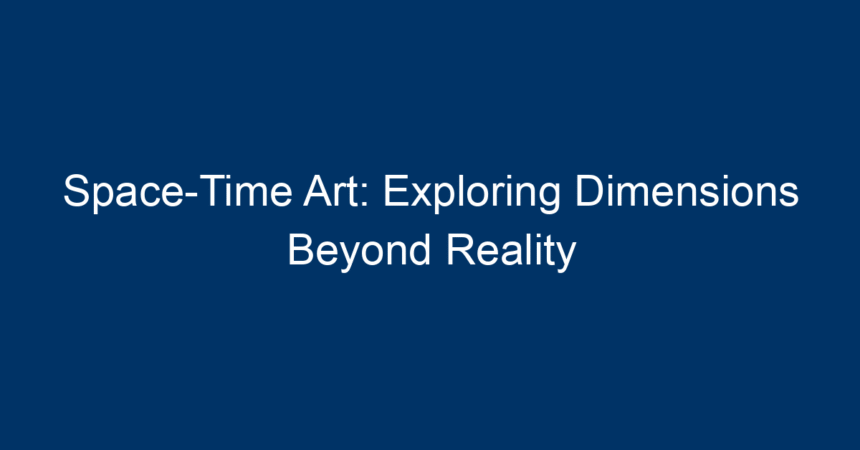In an age where art transcends traditional boundaries, the emergence of space-time art captures the imagination of creators and audiences alike. This innovative expression not only challenges our perception of art but also invites us to ponder the very fabric of reality. In this article, we will delve into the fascinating world of space-time art, examining its principles, techniques, and the impact it has on our understanding of dimensions beyond our everyday experiences.
Understanding Space-Time Art
What is Space-Time Art?
At its core, space-time art integrates the concepts of physical space and time within artistic expressions. This genre goes beyond mere visuals; it is an immersive experience that challenges our perception of both space and time as we interact with it. Space-time art can be found in various mediums, including installation art, virtual reality (VR), augmented reality (AR), and even in performances that unfold over time.
The Intersection of Art and Science
Space-time art draws inspiration from scientific principles, particularly physics and cosmology. Artists explore concepts like relativity, dimensions, and the interconnectedness of the universe, using them as a foundation for their creative output. This unique intersection fosters an engaging dialogue between art and science, inviting audiences to contemplate the mysteries of the cosmos.
Historical Context
Origins of Space-Time Art
The concept of space-time art has roots in various artistic movements. From the abstract expressions of the Cubists to the immersive environments created by contemporary installation artists, the exploration of space has been a long-standing theme in art history. However, it wasn’t until advances in technology and a deeper understanding of physics that artists began to create works that explicitly incorporate the dimensions of time.
Notable Artists and Works
Pioneers in space-time art include figures like Yayoi Kusama, whose infinity rooms create an illusion of never-ending space, and Olafur Eliasson, known for his immersive installations that manipulate light and perception. These artists utilize space, light, and time as essential ingredients in their work, prompting viewers to navigate through and interact with their installations.
Techniques and Mediums
Immersive Installations
One of the most compelling manifestations of space-time art is immersive installations. These spaces often utilize elements such as sound, light, and architecture to create environments where visitors can experience a new perception of reality. For example, installations may evolve over time, changing in response to viewer interaction, or employ technology to create a sense of spatial distortion.
Virtual and Augmented Reality
Advancements in technology have opened new dimensions for space-time art. VR allows artists to create entirely new worlds that defy the constraints of physical space, while AR enhances reality by layering digital elements onto our environment. Artists like Jon Rafman and teamLab use these technologies to construct experiences that invite audience interaction, merging the digital with the physical.
Performance Art
Performance art adds another layer to space-time art by integrating real-time elements into the experience. Performers may engage in actions that alter their surroundings, inviting audiences to contemplate the passage of time and the impact of their presence. This dynamic nature makes performance a fitting medium for exploring complex themes of existence and reality.
The Experience of Space-Time Art
Engaging the Senses
Space-time art actively engages multiple senses, breaking down barriers between the viewer and the artwork. Audiences may experience a feeling of disorientation, wonder, or introspection as they immerse themselves in multi-sensory environments. This engagement prompts deeper reflection on the nature of reality, encouraging visitors to question their understanding of the world around them.
Emotional Resonance
Beyond the visual appeal, space-time art elicits emotional responses. The sense of awe inspired by immersive installations can lead to a feeling of connectedness with the universe. This emotional connection can ignite a passion for exploration, prompting audiences to reflect on their role in the greater tapestry of existence.
The Philosophical Implications
Challenging Perceptions of Reality
Space-time art invites us to reconsider our perceptions of reality. It challenges the linear notion of time and the static concept of space, encouraging viewers to think about the interconnectedness of all things. This philosophical inquiry can lead to a greater understanding of our own existence and a broader perspective on our relationship with the universe.
The Future of Space-Time Art
As technology continues to evolve, the potential for space-time art is limitless. Artists are increasingly experimenting with AI, machine learning, and other emerging technologies to craft experiences that redefine our understanding of space and time. The future promises a new wave of creativity that further blurs the lines between reality and imagination.
Advantages of Embracing Space-Time Art
Enhanced Creativity
Engaging with space-time art fosters creativity by encouraging individuals to think outside conventional boundaries. This genre invites artists and audiences to explore new mediums and methods, pushing the envelope of what art can be.
Interdisciplinary Collaboration
Space-time art promotes collaboration between artists, scientists, and technologists. This interdisciplinary approach not only enriches the artistic process but also leads to innovative solutions to complex questions about our universe.
Broader Accessibility
Virtual and augmented reality have the potential to make space-time art more accessible. By allowing audiences to experience art remotely, artists can reach a global audience, democratizing access to profound artistic experiences.
Actionable Insights for Artists and Audiences
For Artists
- Experiment with Technology: Embrace new tools and platforms to create immersive experiences. Explore VR, AR, and interactive installations to push the boundaries of your art.
- Engage with Scientific Concepts: Delve into scientific literature or collaborate with scientists to infuse your work with deeper meaning and relevance.
- Create Participatory Experiences: Design your installations to invite audience interaction, allowing viewers to become co-creators in the artistic process.
For Audiences
- Participate Fully: When engaging with space-time art, immerse yourself in the experience. Allow yourself to explore and interact without reservation.
- Reflect on Your Experience: Take time to think about how the artwork made you feel and what questions it raised. Consider writing down your thoughts as a personal reflection.
- Explore Further: Seek out exhibitions or online experiences related to space-time art. The more you expose yourself to this genre, the more profoundly you’ll understand its impact.
Conclusion
Space-time art represents a revolutionary frontier in artistic expression, inviting us to explore dimensions beyond our immediate reality. By challenging our perceptions and engaging with philosophical inquiries, this genre fosters a deeper understanding of our existence in the cosmos. As technology evolves, so too will space-time art, paving the way for new creative expressions that inspire curiosity and wonder. Whether you are an artist or an observer, embracing the principles of space-time art can lead to transformative experiences that resonate long after you leave the gallery or installation. Engage, reflect, and let your imagination soar into the vast unknown—your journey into the dimensions of reality awaits!




